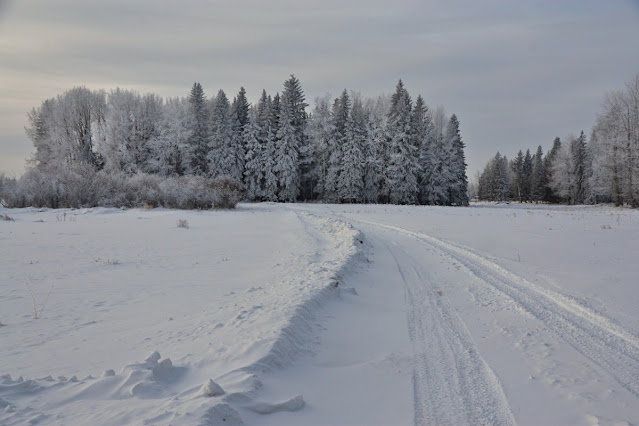We were forecast a La Niña winter: a bit snowier and colder than average for this region. It didn't happen. Early snowfalls were not that early, cold spells not that cold, then a long mild mostly snowfree period. Then ups and downs as we always have here, but snow on the ground has been maybe half to two thirds average, and our coldest nights in the -30 Celsius/-22F range, when extreme nights could have been below -40C/F.
Then came late January: still no serious cold or large amounts of snow, but we had some very windy days. That meant blowing snow, so poor driving visibility (happily I wasn't on the road at the worst times) drifts on roads and- most relevant to me, trees down! Nothing in any damaging or inconvenient spots on the acreage and farm, but at least a half dozen in various areas where I harvest firewood, and most of them actually good wood. Some standing dead trees can be quite decayed and very light/too fast burning, these are okay for getting fires going well, but have no staying power. Others can actually be sort of rotten/wet/heavy, not good for burning. Of course live trees that fall will be green and need some drying before burning. This time there were a few light/dry ones, but most have actually been dry but not decayed- good solid stuff that burns well and long. Wind Mother and Forest Mother have been very kind to me. At the end of last winter I was struggling to find good stuff to cut, this year I have a decent stockpile of cut and semi-cut wood, and more fallen ones still to get to. I've been able to take quite a few days off from cutting wood when it's been cold or snowy.
Here are some videos from this time. These are on YouTube, at the end of the blog, as usual, I will include links for Spectra/Peertube for those who prefer a non-corporate host.
'Wind! Change in Weather Mid-January'
'After the Wind: Trees Down= More Firewood'
'A Little Winter Drama: Sun, Wind, Snow, Sunset-Awesome Alberta Day!'
'Snow Flurries in the Boreal Forest-Heading to Cut Firewood'
February has me wondering if La Niña has finally arrived- nothing extreme but we've been below average for the first couple of weeks, probably lasting till the third week at least, with some nights to -35C/-31F some days -25C/-13F. No records, but cold.And snow- only modest amounts, but many days with fresh snow. I don't long for more snow shovelling, but the snow is an important part of our annual precipitation, with a significant role in recharging wetlands, so I welcome it at the same time as I grumble.
Video: '-25C/-13F Walk in the Frosty Woods'
In the first or second week of February, we reach the Cross-quarter Day, midway between Winter Solstice and Spring Equinox. I've been learning more about these dates, and realised that the exact calculation is a bit complicated, and celebration dates are often fixed to work with beginnings or endings of months, Christian saint days or other convenient calendar points. That's all fine, I guess, absent an active community to calculate dates and co-ordinate observances, for me it is more a gradual shift in season than a moment. I'll make my observations, photos, videos in nature over a period of days with this shift in mind. At times when I actually do any rituals or other celebrations, I'll do it when work schedules and weather permit. So, I'm okay with some fuzziness around the date. Traditionally Latvians celebrate this late winter date, Metenis or Meteņi (from an ancient word suggesting this was originally a New Year celebration), around February 6, though some observances have it varying/later, tied to the dates for Easter etc. The British Imbolc is February 01. This year I think the actual cross-quarter was February 9.
Latvians believe the longer Meteņi is celebrated, the better the harvest will be, so even more of a reason not to worry too much about the date- just go on celebrating!(eating lots/treats are also part of it-okay!)
Here's another blog post specifically on Metenis/ Meteņi
I've usually felt Imbolc was a bit too springy for this climate- though they don't necessarily consider it to be actual spring, they talk about green things, catkins, flowering Snowdrops etc. Those are still quite distant ideas here, where weather can be variable as always in early February, but the main sign of the shift in season is lengthening days and strengthening sun. Latvians call this 'Waiting for Spring' and traditional activities included things like sledding (the longer and faster the ride, the better the harvest). I suspect with climate change, the Metenis in Latvia is looking more like Imbolc, but here spring is definitely something to be waited for, no signs of it yet!
Video: 'Winter Sun-Waiting for Spring- Halfway to Equinox'
Whatever season you may be in as you read this, I hope it is a beautiful one for you. May we continue to learn the lessons of the natural world and continue to be its champions in difficult times. May you find solace, inspiration and strength in the beauty and rhythms of nature.
Here are the links to the videos on Spectra ( a non-corporate owned Fediverse video hosting platform, connected to Mastodon, Pixelfed etc)
As always, you can find me on
I'd love to hear your thoughts and comments on any of those platforms. As for anyone else, if you enjoy my videos, your comments, likes and subscriptions on YouTube are helpful.
If you are able and would like to support me, I have a Ko-fi page; support helps me keep working-more research, more writing, more art!







Comments
Post a Comment